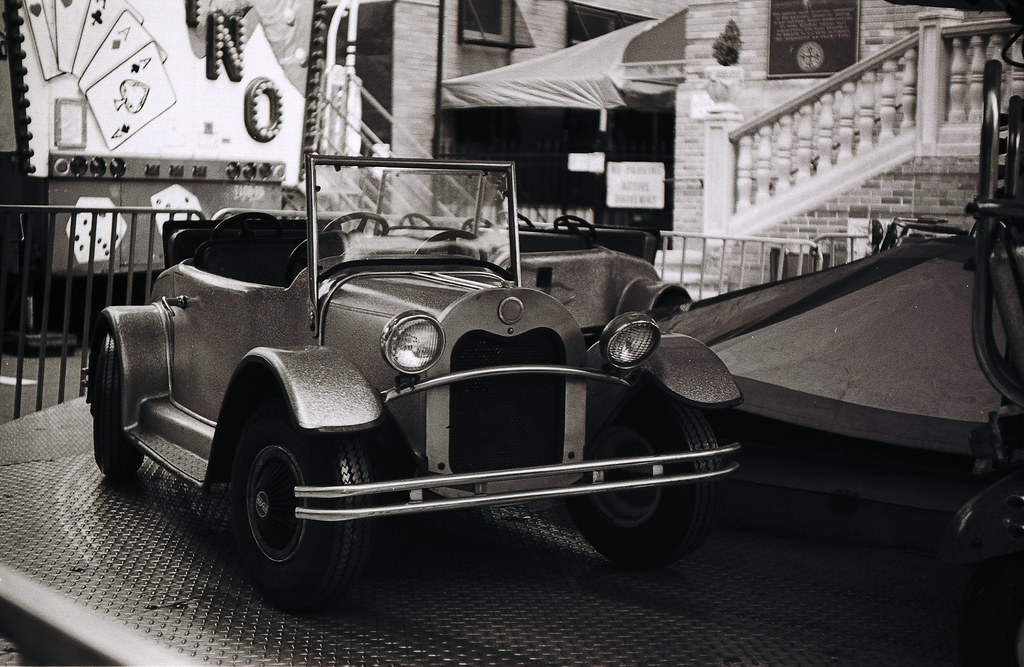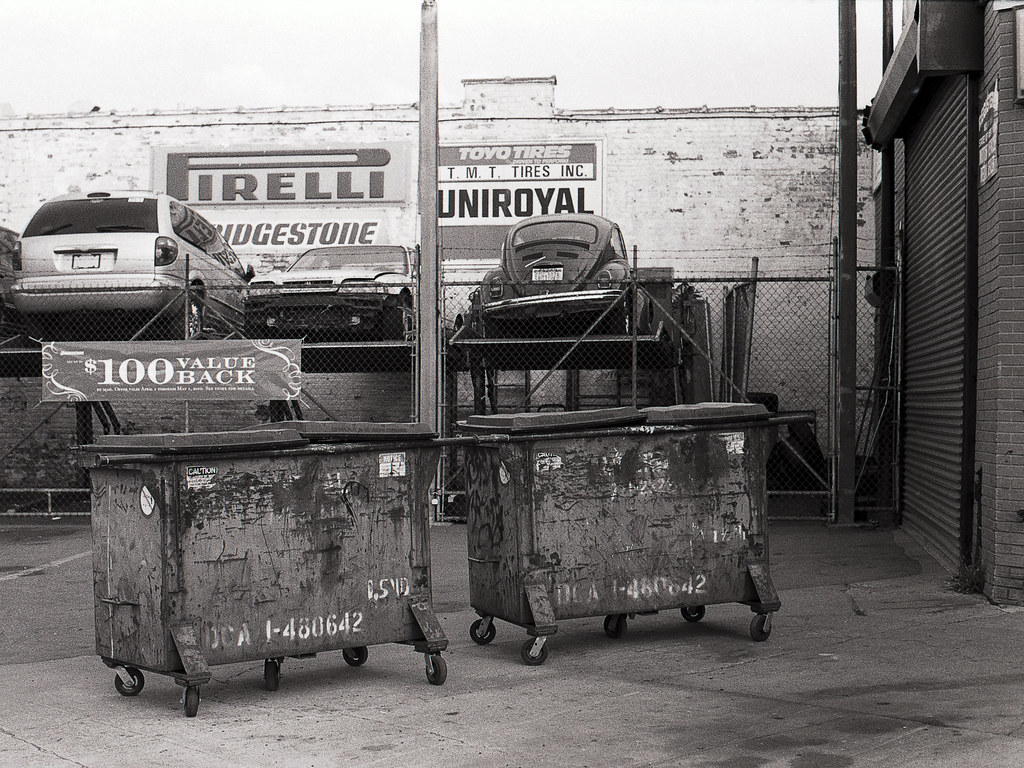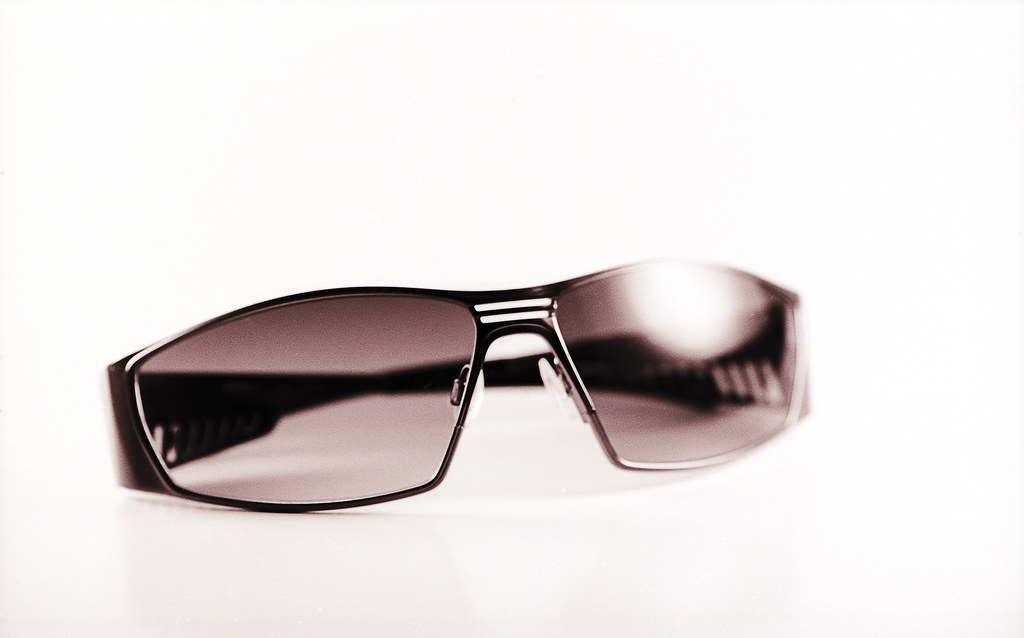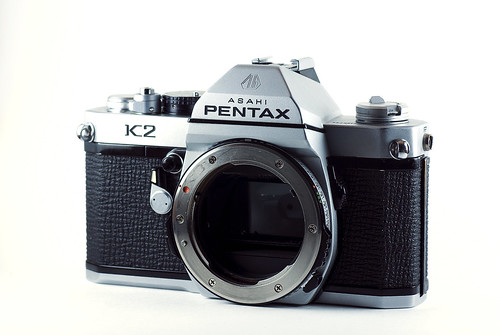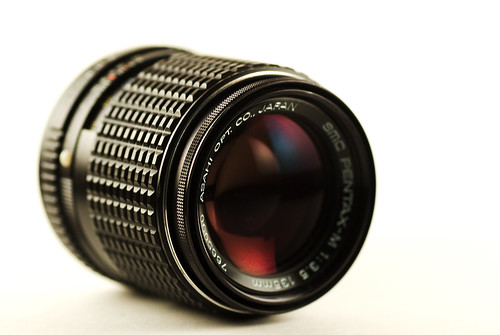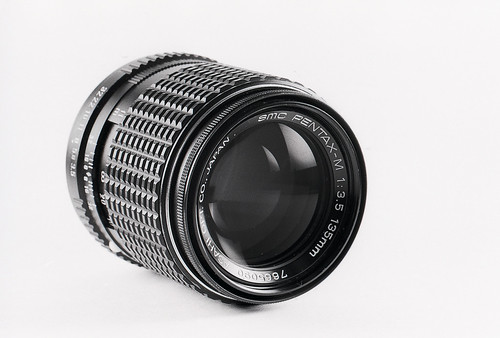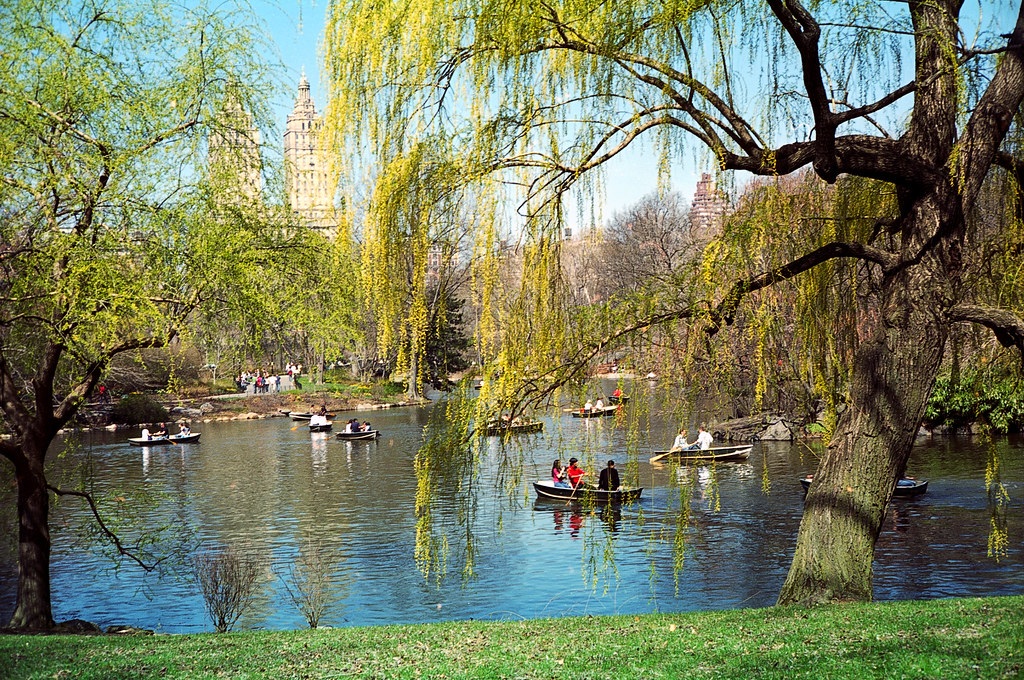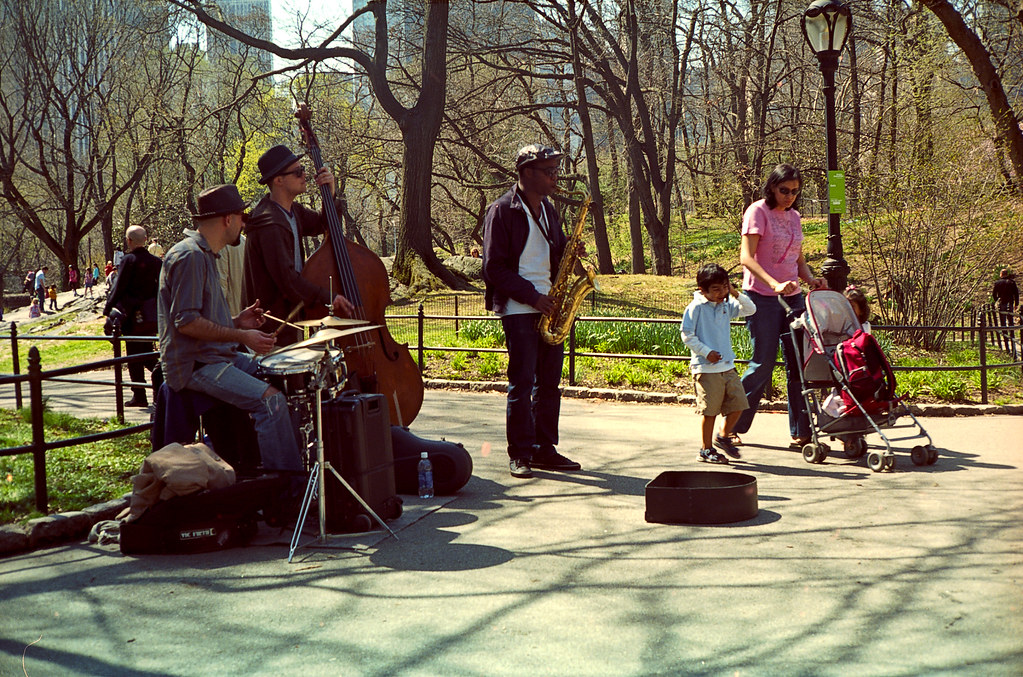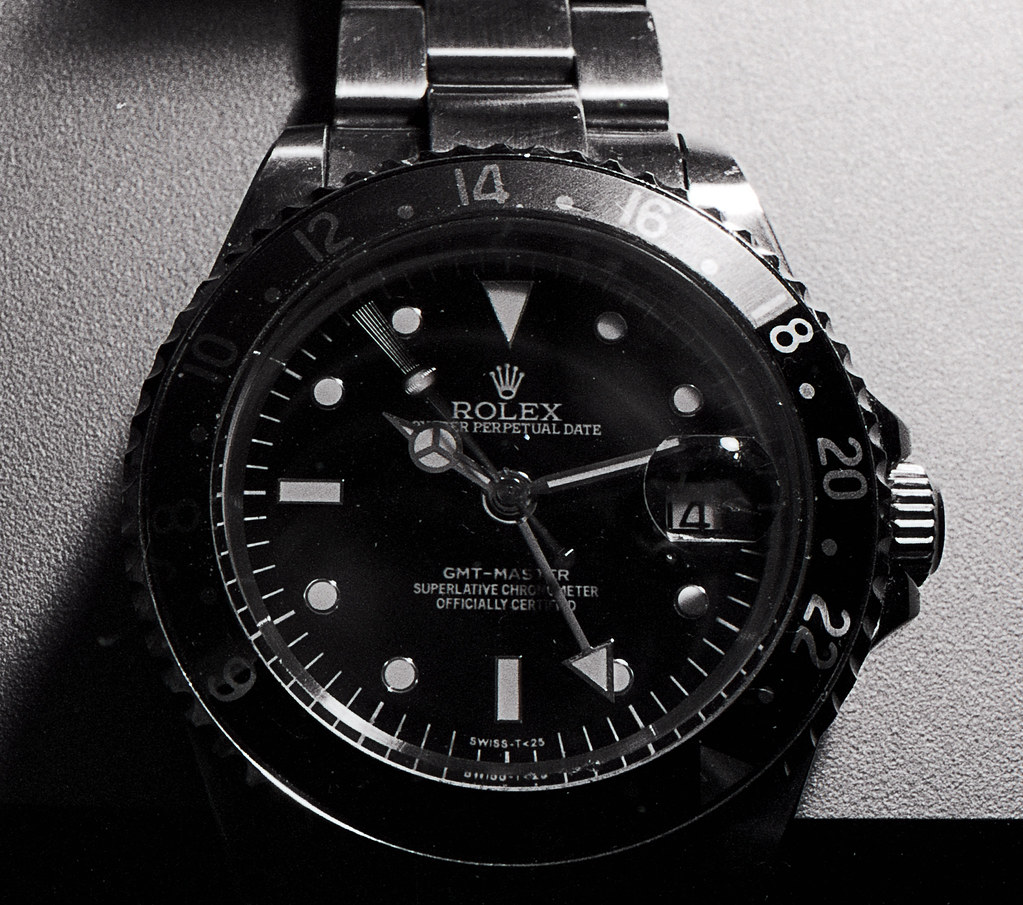Recently I came across the discussion of external light meter. Now, given that even 30-year old cameras have decent TTL-meters, there seems hardly a need for it. But then it got me thinking. What if your camera is 45 years old?
One solution is to just toughen it up and trust the old heuristics. There's the sunny-16-rule which states that on a sunny day you set your aperture to f16 and the shutter speed to the inverse of your film sensitivity. This works quite well:
I should say it works well-ish. In the above, I was merely in the ballpark and the shadows could have done with half a stop of light more. I shot this with a Zorki-4, a Soviet Leica-clone from the 1950s. And I'm also not showing you all the pictures that turned out unusable, usually due to gross under-exposure.
A light meter would certainly take care of all that. But I want something that is small, light and convenient to use. Otherwise, the precious light meter just ends up being like my tripod - seldom used. It turns out that I have found the perfect little light meter: the Gossen Digisix.
It's very small and weighs nothing, just one and a half ounces. I attach the long strap to a belt loop and stick it into the pockets of my trousers. More importantly, it couldn't be easier to use: the little white ball on top knows two positions. If it's centered, as in the above, it takes incident readings. Move it 45 degrees to the right, and it's now a reflective meter useful for scenes where your subject is in a different light than yourself.
You set the ISO sensitivity by keeping the lower red button pressed until you hear a tone and then use the upper button to toggle through the ISO values. This one goes from ISO6 to ISO3200 in third stops, very nice. A reading is done by pushing the upper button and it displays the EV number, plus a black dot per third. So in the photo here, it would indicate an EV of 6 2/3. You can now turn the white ring to match up the EV and you can read aperture/shutter-speed pairs that you can dial in on your camera. The whole process takes two seconds.
And if the scene allows you to use incident meter-readings (which many will), you win again as this type of light measurement is immune to all those things that would normally confuse a camera's reflective meter, such as strong back-lighting. It therefore saves you the occasionally error-prone process of exposure compensation. It also has a few other convenience functions, such as a clock, a timer and a thermometer. It can also be used to gauge the contrast of a scene although I am not sure how well that will work without a spotmeter.
With this meter, I'll be much more likely to take out some of the cameras I've been avoiding recently. It will finally allow me to take off the heavy TTL-metering viewfinder from my Pentax 6x7 and replace it with the much lighter, un-metered folding hood that will allow me to shoot sneakily from the hips instead of pointing a four-pounds contraption at people.
What the Gossen is not is a spotmeter. I have a Sekonic L508 which I use at home for my little macro studio to meter off a gray card. That meter, while it allows you to calculate the trajectory of a rocket you send to the moon, is way too big and complex to take it outside. The Gossen however is perfect for the other scenarios and it'll reward you with perfect exposures every time:
I took the above this morning with an ancient Pentax SV on Ilford HP5+, downrated to ISO200 and pulled one stop during development in HC-110. The camera is 45 years old but still extremely competent, especially once the metering problem was solved.
The Gossen will set you back around $135 if you get it from B&H. So it's not exactly cheap but it does open up three to four of my cameras that have seen less use than they deserve. That makes it a small price to pay in the end. And finally, here's another photo of the meter, leaning casually against the aforementioned Pentax SV:
Did I already say it's tiny?
Sunday, August 15, 2010
Sunday, May 2, 2010
Photographic tinkering
It occurred to me that very few occupations are as inviting to experiments and improvising as photography is. It's in principle a very simple craft and its main tool is really just a box with a provision for some layers of glass elements stacked on top of each other through which light falls on some light-sensitive plane: film or nowadays sensors. The three parameters that interplay when a photo is taken (shutter-speed, aperture of the lens and sensitivity of the light-capturing thing behind the lens) are all easily understandable and all that one has to worry about when being in the field.
And since there is so little to do while taking a photograph, a lot of enthusiasts haven taken things into their own hands to make it more interesting. The internet has detailed instructions on how to build a pinhole camera out of a matchbox, your own tilt-shift lens, even a whole medium-format camera from scratch. And those that are less adventurous, can at least squeeze an infinite amount of entertainment from meticulously developing their film in different developers, comparing the results, or even make their own developer.
For weeks now I had this one sore spot in my refrigerator, namely a left-over roll of Kodak Ekta 100 color-negative film for which I couldn't really find a use. I am really not good at dealing with colors and also despise the fact that C41 film is not very conducive to development at home. Unless of course you pretend it's B&W film and cross-process it in B&W chemicals which is the only type that I have here.
The expected results are basically monochrome photos with low contrast, but with an unpredictable color cast. Depending on the film it's either orange or (quite common). You never really know what you get. Sometimes you get negatives with an enormous amount of grain, sometimes however you wont. You also wont find these handy development charts that tell you how long to develop a particular type of film short at a particular speed in a particular developer at a particular temperature. It's a photographic wild-west, so how could I resist?
So I did what I generally do nowadays when I don't want to leave the house. I set my camera on a tripod, find some domestic item to put into my macro studio (a pair of sunglasses this time), spot-meter off a gray card and then quickly shoot away to get my 24 or 36 exposures done. Since I really didn't have a clue how any of my available developers (DD-X, Ilfosol 3 and HC-110) would behave towards color-film, I just grabbed Ilfosol (it served me well with my previous roll of Efke KB25, so why not) and used the development times for Delta 100 as a starting point. I would have developed for nine minutes, but my tap water is at best 21 degrees in summer, so I subtracted half a minute and I was set.
And here's what emerged from the development tank:
I very slightly adjusted curves in Photoshop (mostly clipping on the right side of the histogram to make the whites actually white) but that was all. I like it a lot. In particular, the film has retained all of its good traits (low grain, high resolution) and lost its bad ones (lab-processing, the color;-). As expected, there is a noticeable color shift, but its towards the warm amber instead of the dreaded orange. Funnily, it's an accurate reproduction of the glasses' real colors.
And since there is so little to do while taking a photograph, a lot of enthusiasts haven taken things into their own hands to make it more interesting. The internet has detailed instructions on how to build a pinhole camera out of a matchbox, your own tilt-shift lens, even a whole medium-format camera from scratch. And those that are less adventurous, can at least squeeze an infinite amount of entertainment from meticulously developing their film in different developers, comparing the results, or even make their own developer.
For weeks now I had this one sore spot in my refrigerator, namely a left-over roll of Kodak Ekta 100 color-negative film for which I couldn't really find a use. I am really not good at dealing with colors and also despise the fact that C41 film is not very conducive to development at home. Unless of course you pretend it's B&W film and cross-process it in B&W chemicals which is the only type that I have here.
The expected results are basically monochrome photos with low contrast, but with an unpredictable color cast. Depending on the film it's either orange or (quite common). You never really know what you get. Sometimes you get negatives with an enormous amount of grain, sometimes however you wont. You also wont find these handy development charts that tell you how long to develop a particular type of film short at a particular speed in a particular developer at a particular temperature. It's a photographic wild-west, so how could I resist?
So I did what I generally do nowadays when I don't want to leave the house. I set my camera on a tripod, find some domestic item to put into my macro studio (a pair of sunglasses this time), spot-meter off a gray card and then quickly shoot away to get my 24 or 36 exposures done. Since I really didn't have a clue how any of my available developers (DD-X, Ilfosol 3 and HC-110) would behave towards color-film, I just grabbed Ilfosol (it served me well with my previous roll of Efke KB25, so why not) and used the development times for Delta 100 as a starting point. I would have developed for nine minutes, but my tap water is at best 21 degrees in summer, so I subtracted half a minute and I was set.
And here's what emerged from the development tank:
I very slightly adjusted curves in Photoshop (mostly clipping on the right side of the histogram to make the whites actually white) but that was all. I like it a lot. In particular, the film has retained all of its good traits (low grain, high resolution) and lost its bad ones (lab-processing, the color;-). As expected, there is a noticeable color shift, but its towards the warm amber instead of the dreaded orange. Funnily, it's an accurate reproduction of the glasses' real colors.
Labels:
cross-processed,
Ilfosol-3,
kodak ekta 100
Thursday, April 29, 2010
Two shots, same setup, different premises
I've been quite prolific over the past few weeks. Last weekend was a bit of a two-faced affair, with a gorgeous Saturday (which made me go out and waste a roll of Delta 400 - results slightly meh), followed by a Sunday with incessant rain. This gave me the opportunity to finally build my little macro studio which mostly consists of a box of cardboard with the two sides cut out and the gaping holes covered with tracing paper as a diffuser. Softly bent white poster board serves as the seamless backdrop. These things have been done and written about to death so there is no point in further going into great details here. Find DIY instructions on the internet, for example here.
Now, while a setup like this gives you pretty well controlled and soft lighting, it's still not quite as straight-forward in practice as the idea is to eliminate all shadows and get an almost pure white as the backdrop for the object. This shows what I mean:
This I shot digitally and while this gives you an infinite amount of retries, even then you will have to battle with slight unevenness in the lighting, Look at the upper-left corner. This is not lens-vignetting but rather a slight darkening caused by lack of light. So the diffusion is not perfect. Also, take note that this is not what it looks like straight out of the camera. It requires post-processing to make the whites as white as it is and, in particular, to fix the white-balance which always has the tendency to be off. Both the camera and Photoshop will distrust all the white in the frame, resulting in an amber tone.
Using film for shots like this requires a different strategy: First off, you don't get to re-shoot until it's right and you wont get any kind of feedback until the film emerges from the development tank. On the plus-side, it's easier to obtain pure white as bumping the development time will leave the shadows largely intact but bump the highlights. Finally, film (especially B&W) is much more robust as far as white-balance is concerned.
And now behold the following two shots: Identical setup (well, close to; ignore the slightly different angle and relative size of the object), the same lens (Tamron 90mm f/2.8) but different cameras (Pentax K10D versus Pentax K2) but most importantly, one shot digitally and the other shot on film:
The digital one offers color which is nice as it literally makes the coating of the lens visible. The depth-of-field is too low. I was impatient and wanted to try out the just completed macro studio right away, hence I shot hand-held. At ISO 400, I needed f/4.5 to obtain a barely hand-holdable shutter speed of 1/60. The white-balance is slightly too warm, too.
For the second shot, the camera rested firmly on a tripod and this time I used a much smaller aperture (either f/11 or f/16) at a shutter speed of one or two seconds. The film is Efke 25KB. Film of such slow speed is really an anachronism but it's paying huge dividends here. This is almost medium-format territory as far as sharpness and details are concerned. Noise is low but this being B&W film, it is of course still discernible. Find larger-sized versions of this shot here.
What is most striking however is the appearance of a much sharper contrast even though a histogram would disagree and indicate that the above digital shot has in fact darker shadows and brighter highlights.
For those keeping book, I developed the roll of film in Ilford Ilfosol-3 (diluted 1+19) for 7 minutes at 20/68 degrees. Ilfosol is said to be a good developer for slow film and I would agree. The little bit of additional grain it induces is a low price to pay for the higher accutance and local contrast it delivers.
Now, while a setup like this gives you pretty well controlled and soft lighting, it's still not quite as straight-forward in practice as the idea is to eliminate all shadows and get an almost pure white as the backdrop for the object. This shows what I mean:
This I shot digitally and while this gives you an infinite amount of retries, even then you will have to battle with slight unevenness in the lighting, Look at the upper-left corner. This is not lens-vignetting but rather a slight darkening caused by lack of light. So the diffusion is not perfect. Also, take note that this is not what it looks like straight out of the camera. It requires post-processing to make the whites as white as it is and, in particular, to fix the white-balance which always has the tendency to be off. Both the camera and Photoshop will distrust all the white in the frame, resulting in an amber tone.
Using film for shots like this requires a different strategy: First off, you don't get to re-shoot until it's right and you wont get any kind of feedback until the film emerges from the development tank. On the plus-side, it's easier to obtain pure white as bumping the development time will leave the shadows largely intact but bump the highlights. Finally, film (especially B&W) is much more robust as far as white-balance is concerned.
And now behold the following two shots: Identical setup (well, close to; ignore the slightly different angle and relative size of the object), the same lens (Tamron 90mm f/2.8) but different cameras (Pentax K10D versus Pentax K2) but most importantly, one shot digitally and the other shot on film:
The digital one offers color which is nice as it literally makes the coating of the lens visible. The depth-of-field is too low. I was impatient and wanted to try out the just completed macro studio right away, hence I shot hand-held. At ISO 400, I needed f/4.5 to obtain a barely hand-holdable shutter speed of 1/60. The white-balance is slightly too warm, too.
For the second shot, the camera rested firmly on a tripod and this time I used a much smaller aperture (either f/11 or f/16) at a shutter speed of one or two seconds. The film is Efke 25KB. Film of such slow speed is really an anachronism but it's paying huge dividends here. This is almost medium-format territory as far as sharpness and details are concerned. Noise is low but this being B&W film, it is of course still discernible. Find larger-sized versions of this shot here.
What is most striking however is the appearance of a much sharper contrast even though a histogram would disagree and indicate that the above digital shot has in fact darker shadows and brighter highlights.
For those keeping book, I developed the roll of film in Ilford Ilfosol-3 (diluted 1+19) for 7 minutes at 20/68 degrees. Ilfosol is said to be a good developer for slow film and I would agree. The little bit of additional grain it induces is a low price to pay for the higher accutance and local contrast it delivers.
Labels:
Efke 25KB,
Ilfosol-3,
macro studio,
Pentax K10D,
Pentax K2,
Tamron 90mm f/2.8
Thursday, April 8, 2010
The resurrection of the Sears 135mm f/2.8
Sort of. As I had mentioned earlier, I had arranged for a replacement for my Sears 135mm f/2.8 lens which arrived today by mail. To my dismay, this new specimen is a distinctly different model: For one, it's considerably bulkier and it comes with a 55mm thread instead of the 52mm of my old one. This is a bit of a shame since at this point I don't actually have any 55mm filters. Also, it's lacking the super-multi-coated designation on the lens front so this one might only be single coated.
I suspect it is the previous model of the same lens so at least optically it might be identical. Here she is on my K2 which still has that yet-unfinished roll of film from last weekend in it:
I cheated a little and made the new Sears look bigger by using a wide-angle close-focus lens.
Incidentally, I used another Sears lens for this photo, a 28mm f/2.8 which I got in an M42 mount that I swapped out against a K-mount of another broken 28mm lens. It no longer focuses to infinity but does sport an A setting so even my K10D can control the aperture. :-) And it still does close-focus, naturally.
I suspect it is the previous model of the same lens so at least optically it might be identical. Here she is on my K2 which still has that yet-unfinished roll of film from last weekend in it:
I cheated a little and made the new Sears look bigger by using a wide-angle close-focus lens.
Incidentally, I used another Sears lens for this photo, a 28mm f/2.8 which I got in an M42 mount that I swapped out against a K-mount of another broken 28mm lens. It no longer focuses to infinity but does sport an A setting so even my K10D can control the aperture. :-) And it still does close-focus, naturally.
Labels:
Pentax K10D,
Pentax K2,
sears 135mm f/2.8,
Sears 28mm f/2.8
Sunday, April 4, 2010
A day out with a Yashica rangefinder
This Good Friday I did three things (all at the same time) that I normally never do:
So by and large, I enjoyed handling this Yashica. I doubt I will abandon my SLRs for it anytime soon, but I can see occasions where it could be more useful. What I need to do is find an application for the rather idiosyncratic focal length of 47mm. On my morning out in Central Park, I found it either too wide or not wide enough, but never quite right. Oddly enough, I often have a 50mm lens on my SLRs and find that focal length perfectly natural. I blame the viewfinder which forces me to place things within the marked area and thus makes you believe you have a wider lens on it.
- I shot with a rangefinder camera, the Yashica Electro 35 GSN.
- I shot color film, Kodak Ekta 100.
- I went to Central Park at a time where tourists would be flooding the place.
The Yashica I acquired a week before, off eBay of course. I felt I needed to add a new type of camera to my collection that up to this point only consisted of 35mm film SLRs (all Pentax except for a Nikkormat FT) and a Pentax 6x7 medium format rig. I was on paper quite familiar with rangefinders but in practice, things are always a little more finicky. It took me a while to figure out how to focus. The Yashica has a little yellow area in the middle of the viewfinder and this is where the focusing mechanism shifts the ghost-image in place. It's quite subtle and easy to overlook.
As with most rangefinders, the shutter action is very quiet and inaudible in the streets of New York. Theoretically, this would make it a perfect street camera but I believe in reality it is a little too bulky for this. It's a slightly bigger than both my Pentax K2 as well as the rather substantial Nikkormat.
Other than that, the camera is parallax-corrected. I found this to be only partially true though. While the frame markers shift up and down depending on the focus distance, they do not shift horizontally. The viewfinder is positioned on top and left of the lens and indeed, some of my photos showed odd framing. Things that I expected to be in the photo were clipped off on the left of the frame and instead I had some extraneous stuff on the right. So this is something the photographer will have to compensate for.
Focusing seems more difficult than with any of my single-lens reflexes. I didn't find any really sharp images when I got my first roll back. Meanwhile, the camera has a non-interchangeable 47mm f/1.7 lens attached to it. It earns points for being fast but due to my lack of focusing skills, I will probably stick with smaller apertures.
The Yashica's only metering mode is aperture-preferred, so you dial in the aperture and the camera steplessly selects what it considers an appropriate shutter-speed (its meter sits atop the lens so it has no TTL metering). It wont however tell you what it has chosen - all you get is a warning for slow speeds and overexposure.
Anyway, to cut long things short, the Yashica is a curious camera with a very pretty body that handles well and offers too little to distract you from taking photos. And here are two that I found tolerable enough to escape the bin:
In full size (find it here), you will see that the stem of the tree on the right is sharpest. This is strange as I recall I had the lens focused to infinity.
This might be more in the domain of the Yashica. There's even less in focus than in the previous photo, but at least it features some people doing interesting things.
So by and large, I enjoyed handling this Yashica. I doubt I will abandon my SLRs for it anytime soon, but I can see occasions where it could be more useful. What I need to do is find an application for the rather idiosyncratic focal length of 47mm. On my morning out in Central Park, I found it either too wide or not wide enough, but never quite right. Oddly enough, I often have a 50mm lens on my SLRs and find that focal length perfectly natural. I blame the viewfinder which forces me to place things within the marked area and thus makes you believe you have a wider lens on it.
R.I.P.
So I was meandering through Astoria Park this morning, armed with my Pentax K2 on which my beloved Sears 135mm f/2.8 was sitting. I had some problems with the depth-of-field preview - I had to push the button on the camera body several times before the viewfinder would finally dim down. It didn't take long that not even the most obstinate and furious button mashing would have any effect. I took off the lens and fiddled with the stop-down lever only to realize that the lens would no longer stop down. Sticky aperture blades, certainly.
What sounds harmless and petty is sadly the death of this wonderful lens. It's a curious dilemma: It can probably be repaired, although finding someone who can fix a 20 year old lens might not be easy. And while I am in love with this lens more than with any other of my lenses, it also happens to be one of my cheapest. You can get decent specimens for around $20. So instead I decided to quickly take it apart to see if there's anything I can do. But as always, the aperture blades are hidden underneath the rear element of the lens which is glued to the outer shell. No go, therefore.
So I didn't hesitate and arranged instantly for a replacement. There's a decent number of those available on eBay at any given time, fortunately. Mine will be shipped from California so I have to wait a few days. I just hope it will perform equally well - one never knows with these off-brand lenses which are often rebadged.
As a final tribute to this great little performer, here's a few photos I've taken with it:
It's an almost ideal portrait lens. The focal lens is just about perfect and f/2.8 is plenty for blurring out any distracting elements in the background. The above was shot with the Pentax ME Super on Ilford HP5+ pulled one stop (Ilfotec DD-X 1+4 for 8 minutes at 20/68 degrees)
And it's sharp. In the above, I used around 28mm of extension tubes to focus that closely (mine is the non-macro version of this lens). Shot on Ilford Delta 100 and developed in Ilfotec DD-X, 1+4 for 12 minutes at 20/68 degrees.
This Sears often gets an honorable mentioning when 135mm lenses in the Pentax K-mount are discussed but more often than not, it gets good marks for its low price but is forced to stand behind the smc PENTAX 1:2.5 135mm or its slower and cheaper sister, the smc PENTAX-M 1:3.5 135mm.
I will miss her. That is, until the replacement has arrived!
What sounds harmless and petty is sadly the death of this wonderful lens. It's a curious dilemma: It can probably be repaired, although finding someone who can fix a 20 year old lens might not be easy. And while I am in love with this lens more than with any other of my lenses, it also happens to be one of my cheapest. You can get decent specimens for around $20. So instead I decided to quickly take it apart to see if there's anything I can do. But as always, the aperture blades are hidden underneath the rear element of the lens which is glued to the outer shell. No go, therefore.
So I didn't hesitate and arranged instantly for a replacement. There's a decent number of those available on eBay at any given time, fortunately. Mine will be shipped from California so I have to wait a few days. I just hope it will perform equally well - one never knows with these off-brand lenses which are often rebadged.
As a final tribute to this great little performer, here's a few photos I've taken with it:
It's an almost ideal portrait lens. The focal lens is just about perfect and f/2.8 is plenty for blurring out any distracting elements in the background. The above was shot with the Pentax ME Super on Ilford HP5+ pulled one stop (Ilfotec DD-X 1+4 for 8 minutes at 20/68 degrees)
And it's sharp. In the above, I used around 28mm of extension tubes to focus that closely (mine is the non-macro version of this lens). Shot on Ilford Delta 100 and developed in Ilfotec DD-X, 1+4 for 12 minutes at 20/68 degrees.
This Sears often gets an honorable mentioning when 135mm lenses in the Pentax K-mount are discussed but more often than not, it gets good marks for its low price but is forced to stand behind the smc PENTAX 1:2.5 135mm or its slower and cheaper sister, the smc PENTAX-M 1:3.5 135mm.
I will miss her. That is, until the replacement has arrived!
Subscribe to:
Posts (Atom)
